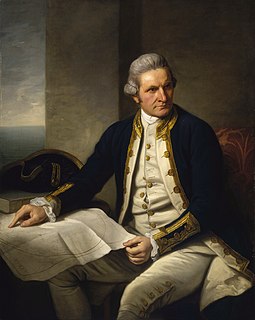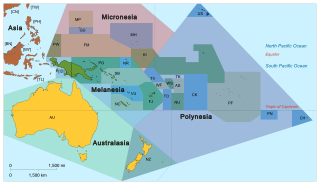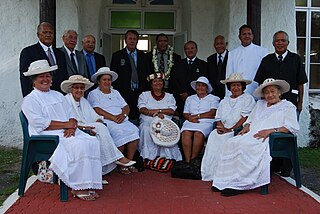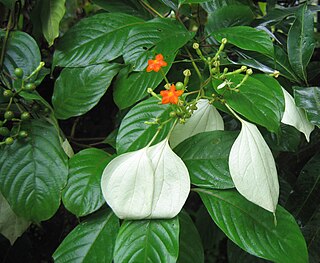
The Cook Islands are a self-governing island country in the South Pacific Ocean in free association with New Zealand. It comprises 15 islands whose total land area is 240 square kilometres (93 sq mi). The Cook Islands' Exclusive Economic Zone (EEZ) covers 1,960,027 square kilometres (756,771 sq mi) of ocean.

Captain James Cook was a British explorer, navigator, cartographer, and captain in the British Royal Navy, famous for his three voyages between 1768 and 1779 in the Pacific Ocean and to Australia in particular. He made detailed maps of Newfoundland prior to making three voyages to the Pacific, during which he achieved the first recorded European contact with the eastern coastline of Australia and the Hawaiian Islands, and the first recorded circumnavigation of New Zealand.

The Hawaiian Islands are an archipelago of eight major islands, several atolls, numerous smaller islets, and seamounts in the North Pacific Ocean, extending some 1,500 miles from the island of Hawaiʻi in the south to northernmost Kure Atoll. Formerly the group was known to Europeans and Americans as the Sandwich Islands, a name that James Cook chose in honor of the then First Lord of the Admiralty John Montagu, 4th Earl of Sandwich. Cook came across the islands by chance when crossing the Pacific Ocean on his Third Voyage, on board HMS Resolution; he was later killed on the islands on a return visit. The contemporary name of the islands, dating from the 1840s, is derived from the name of the largest island, Hawaiʻi Island.

Pacific Islanders, Pacificer, Pasifika, or Pasefika, are the peoples of the Pacific Islands. It is a geographic and ethnic/racial term to describe the inhabitants and diaspora of any of the three major sub-regions of Oceania. It is also sometimes used to describe inhabitants of the Pacific islands.

Fabian Gottlieb Thaddeus von Bellingshausen was a Russian naval officer, cartographer and explorer, who ultimately rose to the rank of admiral. He participated in the First Russian circumnavigation of the globe and subsequently became a leader of another circumnavigation expedition that discovered the continent of Antarctica. Like Otto von Kotzebue and Adam Johann von Krusenstern, Bellinghausen belonged to the cohort of prominent Baltic German navigators who helped Russia launch her naval expeditions.

Raiatea is the second largest of the Society Islands, after Tahiti, in French Polynesia. The island is widely regarded as the "centre" of the eastern islands in ancient Polynesia and it is likely that the organised migrations to the Hawaiian Islands, New Zealand and other parts of East Polynesia started at Raiatea.

The Cook Islands national rugby league team has been participating in international rugby league football competition since 1986. The team is controlled by the governing body for rugby league in Cook Islands, Cook Islands Rugby League Association (CIRLA), which is currently a member of the Asia-Pacific Rugby League Confederation (APRLC). They are currently ranked 23rd in the RLIF World Rankings.
Rugby league is played in Tokelau and by Tokelaun ex-pats in New Zealand. A domestic competition has been established and a representative team has begun to play internationals against other Pacific teams.

Kuhl's lorikeet, also called the Rimitara lorikeet, Kuhl's lory, Manu 'Ura or Kura , is a species of lorikeet in the family Psittaculidae. It is one of several species of Vini lorikeets found in islands ranging across the South Pacific. The Kuhl for whom Nicholas Aylward Vigors named the bird in 1824 was Heinrich Kuhl, a German ornithologist whose survey of the parrots, Conspectus psittacorum, had appeared in 1819.

The House of Ariki is a parliamentary body in the Cook Islands. It is composed of Cook Islands high chiefs (ariki), appointed by the Queen's Representative. There are up to twenty-four members, representing different islands of the Cooks.

The following outline is provided as an overview of and topical guide to the Cook Islands:
Akava'ine is a Cook Islands Māori word which has come, since the 2000s, to refer to transgender people of Māori descent from the Cook Islands.

Nephele oenopion is a moth of the family Sphingidae. It is known from Africa.
Areariki Arthur Cowan "Riki" Cowan is a New Zealand rugby league footballer who represented New Zealand and the Cook Islands.

Mussaenda is a genus of flowering plants in the family Rubiaceae. They are native to the African and Asian tropics and subtropics. Several species are cultivated as ornamental plants.

The culture of the Cook Islands reflects the traditions of its fifteen islands as a Polynesian island country, spread over 1,800,000 square kilometres (690,000 sq mi) in the South Pacific Ocean. It is in free association with New Zealand. Its traditions are based on the influences of those who settled the islands over several centuries. Polynesian people from Tahiti settled in the Cook Islands in the 6th century. The Portuguese captain, Pedro Fernandes de Queirós, made the first recorded European landing in the islands in the early 17th century, and well over a hundred years later, in the 18th century, the British navigator, Captain James Cook arrived, giving the islands their current name. Missionaries developed a written language, bringing schools and Christianity to the Cook Islands in the early 19th century. Cook Islands Māori, also known as Māori Kūki 'Āirani or Rarotongan, is the country's official language.
The Miss Cook Islands is the national beauty pageant in the Cook Islands in under Miss Cook Islands Association (MCIA). The current reigning titleholder is Tajiya Sahay who was crowned in October 2019.

Mussaendeae is a tribe of flowering plants in the family Rubiaceae and contains about 221 species in 8 genera. Its representatives are found from tropical and southern Africa, the western Indian Ocean, to tropical and subtropical Asia and the Pacific region.

Cook Islands–India relations refers to bilateral relations between the Cook Islands and India.
Kuning, also spelled kyuning or kiyuning and Anglicized as yellow rice or turmeric rice, is a Filipino rice dish cooked with turmeric, lemongrass, salt, bay leaves, and other spices to taste. It originates from the island of Mindanao and is a staple food among the Maranao people of Lanao del Sur. It is related to the Indonesian nasi kuning of neighboring Sulawesi, but it does not use coconut milk. The dish is characteristically yellow because of the use of turmeric.














